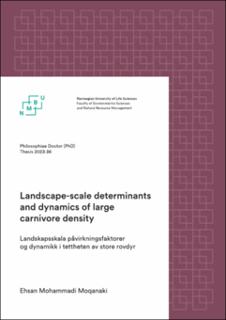| dc.description.abstract | 1. Wildlife populations live in increasingly human-altered landscapes. Either because of their intrinsic values or due to instrumental values to humans, wildlife populations are monitored to inform about their current status and population trends and to forecast their future status in response to possible changes in their environment. Monitoring wildlife across spatial units and over time is a first step towards adaptive and evidence-based management.
2. This PhD dissertation consists of four articles that are centered on developing new methods, enhancing concepts, and showcasing applications of novel analytical approaches for quantifying landscape-level wildlife population density using noninvasive monitoring data. At the core of this PhD dissertation lie spatially explicit analytical models, namely spatial capture-recapture (SCR), with the ability to yield scale-transcending estimates of population parameters, while accounting for imperfect detection. This PhD dissertation is motivated by applied questions raised during noninvasive genetic monitoring of large carnivores in the Scandinavian Peninsula. However, the methodology and findings have broader implications.
3. The first two articles focus on understanding and mitigating the consequences of spatially variable and autocorrelated detection probability when analyzing wildlife monitoring data. Detection probability – the probability of detecting an individual from the target population, can vary across the study area, because of, for example, certain landscape characteristics or the specifics of the sampling design. Spatial autocorrelation in detection probability occurs when detectability is more similar among neighboring than distant sampling locations or devices. Both articles I and II use simulations to create and test many scenarios that may occur during real-life sampling of wildlife in monitoring studies. Article I evaluates the consequences of not accounting for spatial variation in detectability when analyzing monitoring data with SCR, with a specific focus on the impact on estimates of population size. This study shows that a misspecified SCR model performs reasonably well in many situations, from low to even intermediate levels of spatial variation in detectability. However, Article I identifies problematic cases of highly spatially variable and autocorrelated detection, which can lead to pronounced negative bias in population size estimates. Some of these extreme scenarios are expected in the large-scale monitoring of large carnivores in Scandinavia, which led to a follow-up study in the next chapter of this PhD.
4. Article II describes and tests three novel modeling approaches to account for spatially variable and autocorrelated detection probability in SCR with random effects. This study extends SCR with generalized linear mixed models (GLMMs) and compares the performance of the SCR-GLMMs that do and do not specifically account for spatial autocorrelation in detection probability. Article II then applies the new modeling approaches to Scandinavian brown bear Ursus arctos monitoring data from central Sweden, where the majority of the DNA data was collected opportunistically by volunteers and no reliable measure of sampling effort was available to infer spatially variable detectability. This empirical case study demonstrates the application of the proposed modeling approaches and suggests considerable spatial heterogeneity in the detection of bears, where detectability decreases in an east-to-west direction towards the Swedish-Norwegian border. Further, Article II discusses solutions to identify potential sampling gaps, where variation in the effort is not fully known and highlights computation trade-offs in using such novel SCR analyses in wildlife monitoring studies.
5. The next two articles demonstrate empirical applications of quantifying variation in wildlife population density and its determinants at the population level. Our current understanding of wildlife space use and habitat selection is dominated by geographically limited studies that often make inferences from a few instrumented individuals. Both articles III and IV use noninvasive genetic monitoring data of the wolverine Gulo gulo across the species’ entire range in the Scandinavian Peninsula and assess sex-specific responses of the wolverine density to a suit of historical and present-day environmental covariates. Both these articles predict the Scandinavian wolverine density distribution and provide estimates of population size. Article III, as a prelude to the next chapter, identifies the factors influencing the current density distribution of the wolverine, with a focus on the role of the relict range along the Swedish-Norwegian border, where the wolverine survived intense human persecution by early 1970s. Article III reveals that distance from this transboundary alpine region is still one of the most important determinants of wolverine density and the highest female and male wolverine densities are expected closer to the relict range. However, current management conditions to limit wolverine expansion, especially in southern Norway, interact with distance from the relict range, and together with other topographic, climatic, and prey-related factors, have shaped the current density distribution of the wolverine in Scandinavia. This study is the first to look into the density determinants of the Scandinavian wolverine population across its entire geographic range.
6. Article IV builds on the findings from Article III and quantifies the dynamics of density determinants of the Scandinavian wolverine over a nine-year monitoring period. This study quantified the change in the impact of the environmental covariates over the past decade, as the wolverine has successfully expanded from the alpine relict range into the boreal forest. Article IV uses recently developed open-population SCR models that provide not only estimates of annual density and its determinants, but also estimates of the demographic parameters (i.e., recruitment and survival) needed to predict changes in the population dynamics. This study reveals that, on the one hand, whereas the role of the relict range is still important for determining the wolverine’s density distribution, its significance is diminishing over time. On the other hand, forest is appearing more and more as a significant predictor of today’s wolverine density. Article IV tracks temporal trends in the main determinants of male and female wolverine densities and it discusses the results in relation to the population recovery of the wolverine in Scandinavia in the presence of ongoing human pressure. | en_US |

